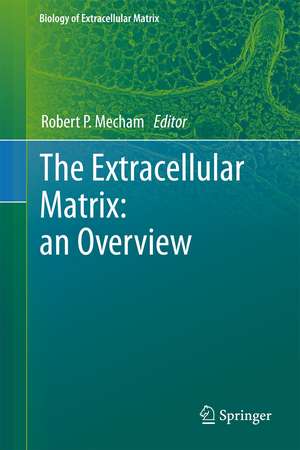The Extracellular Matrix: an Overview: Biology of Extracellular Matrix
Editat de Robert Mechamen Limba Engleză Paperback – 21 apr 2013
This volume of the series “Biology of Extracellular Matrix” provides a timely overview of the structure, regulation, and function of the major macromolecules that make up the extracellular matrix. It covers topics such as collagen types and assembly of collagen-containing suprastructures, basement membrane, fibronectin and other cell-adhesive glycoproteins, proteoglycans, microfibrils, elastin, fibulins and matricellular proteins, such as thrombospondin. It also explores the concept that ECM components together with their cell surface receptors can be viewed as intricate nano-devices that allow cells to physically organize their 3-D-environment. Further, the role of the ECM in human disease and pathogenesis is discussed as well as the use of model organisms in elucidating ECM function.
Toate formatele și edițiile
| Toate formatele și edițiile | Preț | Express |
|---|---|---|
| Paperback (1) | 1822.89 lei 6-8 săpt. | |
| Springer Berlin, Heidelberg – 21 apr 2013 | 1822.89 lei 6-8 săpt. | |
| Hardback (1) | 1827.32 lei 6-8 săpt. | |
| Springer Berlin, Heidelberg – 17 feb 2011 | 1827.32 lei 6-8 săpt. |
Din seria Biology of Extracellular Matrix
- 27%
 Preț: 1502.96 lei
Preț: 1502.96 lei - 18%
 Preț: 940.57 lei
Preț: 940.57 lei - 18%
 Preț: 943.43 lei
Preț: 943.43 lei - 18%
 Preț: 937.56 lei
Preț: 937.56 lei - 24%
 Preț: 792.87 lei
Preț: 792.87 lei - 5%
 Preț: 713.33 lei
Preț: 713.33 lei - 5%
 Preț: 718.50 lei
Preț: 718.50 lei - 5%
 Preț: 1297.54 lei
Preț: 1297.54 lei - 18%
 Preț: 1110.41 lei
Preț: 1110.41 lei - 18%
 Preț: 1123.04 lei
Preț: 1123.04 lei - 18%
 Preț: 947.35 lei
Preț: 947.35 lei - 24%
 Preț: 955.38 lei
Preț: 955.38 lei - 20%
 Preț: 1040.97 lei
Preț: 1040.97 lei - 18%
 Preț: 892.59 lei
Preț: 892.59 lei - 18%
 Preț: 1109.16 lei
Preț: 1109.16 lei
Preț: 1822.89 lei
Preț vechi: 2223.04 lei
-18% Nou
Puncte Express: 2734
Preț estimativ în valută:
348.89€ • 376.61$ • 292.55£
348.89€ • 376.61$ • 292.55£
Carte tipărită la comandă
Livrare economică 18 aprilie-02 mai
Preluare comenzi: 021 569.72.76
Specificații
ISBN-13: 9783642267192
ISBN-10: 364226719X
Pagini: 440
Ilustrații: XIV, 426 p.
Dimensiuni: 155 x 235 x 23 mm
Greutate: 0.62 kg
Ediția:2011
Editura: Springer Berlin, Heidelberg
Colecția Springer
Seria Biology of Extracellular Matrix
Locul publicării:Berlin, Heidelberg, Germany
ISBN-10: 364226719X
Pagini: 440
Ilustrații: XIV, 426 p.
Dimensiuni: 155 x 235 x 23 mm
Greutate: 0.62 kg
Ediția:2011
Editura: Springer Berlin, Heidelberg
Colecția Springer
Seria Biology of Extracellular Matrix
Locul publicării:Berlin, Heidelberg, Germany
Public țintă
ResearchCuprins
An overview of extracellular matrix structure and function.- Fibronectin and other adhesive glycoproteins.- Collagen: suprastructures and collagen fibril assembly.- Asement membrane; Hyaluronan and the Aggregating Proteoglycans.- The small, leucine-rich proteoglycans.- Microfibrils and fibrillin.- Elastin.- Lysyl oxidase and lysyl oxidase-like enzymes.- The Fibulins.- Matricellular proteins.
Textul de pe ultima copertă
Knowledge of the extracellular matrix (ECM) is essential to understand cellular differentiation, tissue development, and tissue remodeling.
This volume of the series “Biology of Extracellular Matrix” provides a timely overview of the structure, regulation, and function of the major macromolecules that make up the extracellular matrix. It covers topics such as collagen types and assembly of collagen-containing suprastructures, basement membrane, fibronectin and other cell-adhesive glycoproteins, proteoglycans, microfibrils, elastin, fibulins and matricellular proteins, such as thrombospondin. It also explores the concept that ECM components together with their cell surface receptors can be viewed as intricate nano-devices that allow cells to physically organize their 3-D-environment. Further, the role of the ECM in human disease and pathogenesis is discussed as well as the use of model organisms in elucidating ECM function.
This volume of the series “Biology of Extracellular Matrix” provides a timely overview of the structure, regulation, and function of the major macromolecules that make up the extracellular matrix. It covers topics such as collagen types and assembly of collagen-containing suprastructures, basement membrane, fibronectin and other cell-adhesive glycoproteins, proteoglycans, microfibrils, elastin, fibulins and matricellular proteins, such as thrombospondin. It also explores the concept that ECM components together with their cell surface receptors can be viewed as intricate nano-devices that allow cells to physically organize their 3-D-environment. Further, the role of the ECM in human disease and pathogenesis is discussed as well as the use of model organisms in elucidating ECM function.
Caracteristici
First volume of this re-launched series - An excellent introduction to the biology of the extracellular matrix - Published in collaboration with the American Society for Matrix Biology Includes supplementary material: sn.pub/extras












